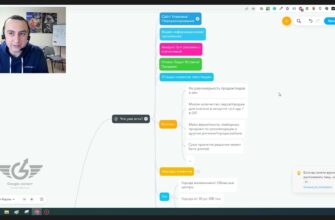- Brief information about the store and what the customer came with
- Start of work on the project. Absence of objects
- Assignment of profitability rates
- Rules for setting profitability
- What size budget should I set?
- Need to remove automatically created objects
- Customizing languages
- Changing the structure of advertising campaigns and indicating profitability
- Analyzing who Google favors
- Steps to take to improve performance
- Tune-up after a period of performance training
- Attention to auction statistics
- What to correct in the signals?
- Using other sets of signals
- Tips for this niche

Hi everyone. My name is Yana Lyashenko, Google logistician. I am engaged in delivery of target audience of business with necessary parameters with the help of Google advertising tools. And in today’s video we’ll be looking at a rather interesting project.
Brief information about the store and what the customer came with
It’s on Prom, of course, which adds that you-know-what flutter of exclusivity. Plus, we’re themed around kitty products. We have scratching posts, toys. There are grooming products and so on.
What do we have? We have an online store that launched and ran its performance quite small, one, two, three, four days. Right?
How many calls and sales will I get by ordering contextual advertising from you?
I need to calculate the conversion of my website Describe
the task
in the application
Calculate potential ad revenue Google
contextual advertising calculator
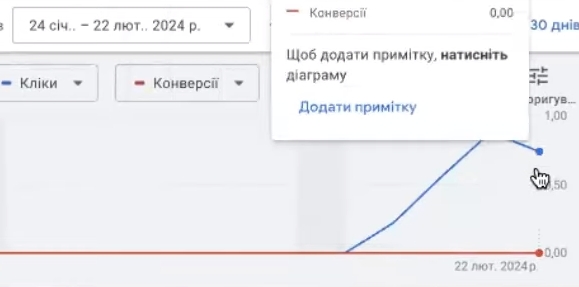
Our expenses are almost 1000 UAH. And this 1000 UAH, it may seem expensive or not expensive enough. We can say this: it is expensive only because of the average price per click, which was well high enough. Although, perhaps, for this niche and not super high. Right? 8 grivnas. We have a total of 120 clicks if you see here.

No conversions. There could be several reasons why we don’t see conversions here. First, we don’t capture phone calls. They may or may not have been real.

And the second reason is we’re using conversions from fourth analytics yes also on a data-driven attribution model. It always counts a little bit less conversions in the beginning while you’re rocking out. So I usually recommend using the attribution model, last click in changes this purchase or put the buy tag at all. On Prom, everything is available now, and soon I’ll have a video on how to separately put that purchase tag or who’s in a hurry, you can look in the Prom Help, it’s all quite, very simple how to do it all, finalize, implement. So, let’s move on.
Start of work on the project. Absence of objects
So we don’t know right now if there are sales or not. We’re assuming it’s not here. What can we do about it? The first thing we’re going to start with, we’re going to start with setting up all the performances, because there’s a good thing here? The good thing is that there are no objects here, because I’m not sure that objects in Performance would be used appropriately. Objects are pictures, texts that can be added with this bid strategy. This bidding strategy, we have “maximum conversion value”. So he could use it in completely different parameters. So that’s not a bad thing.
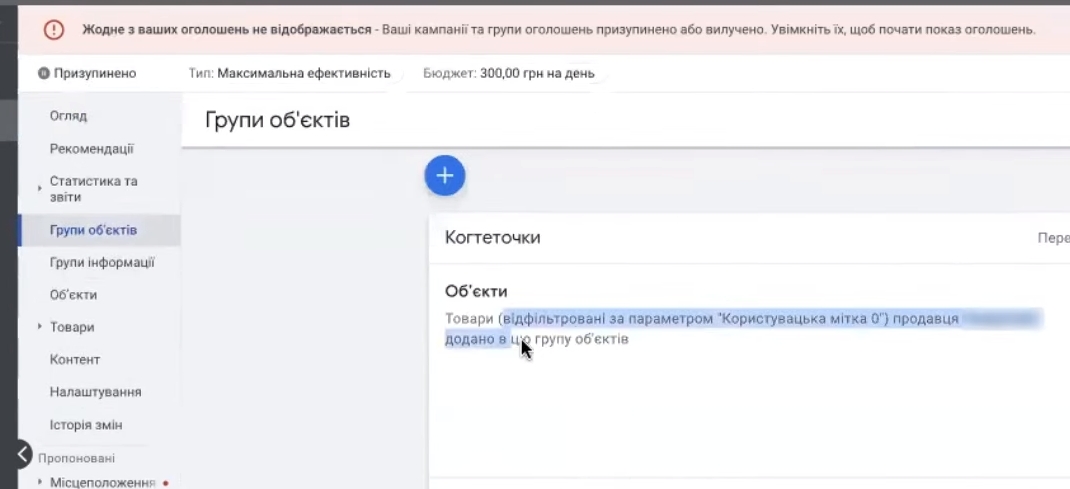
Assignment of profitability rates
Next. Still recommended making a profitability adjustment in the rate designation.

Because we have in this advertising campaign sit quite different goods, in different price range. That is, we have, here I pull up from 79 UAH starts the price of goods, ends with 16 000 UAH. Productivity as it will be right to say. Efficiency of work at such settings, it can be 50×50.
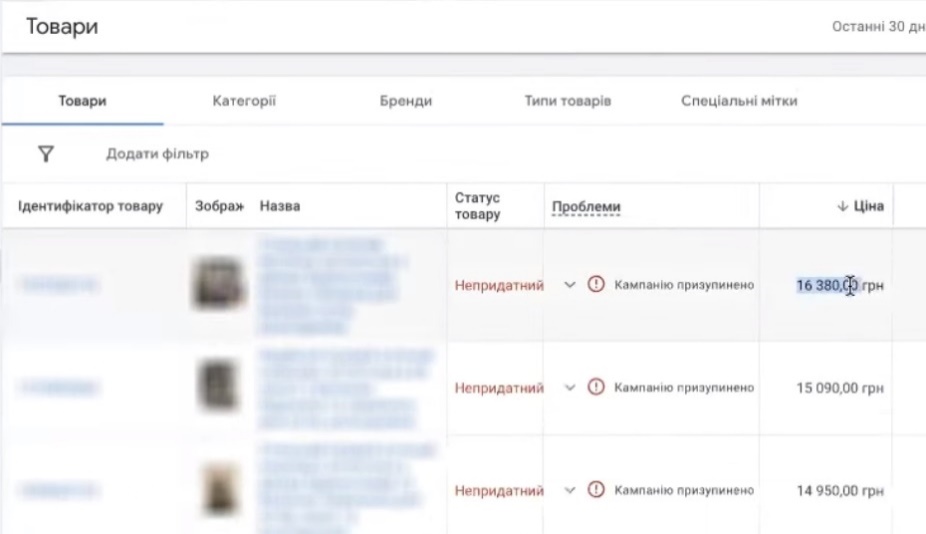
That is, it is desirable to have different profitability settings for different price ranges, or different categories of the same goods. You don’t see profitability as something in the settings like a toggle button that will strive to achieve this result. No, you have to remember that although initially sewn into the performance work such algorithms as to reduce over a certain period of time the discrepancy between the fact that it in profitability gets and what you set in the settings. But we know that this is a system that also earns money. So sooner or later it will still force that discrepancy on you all the time. You perceive profitability not as a setting and a goal to achieve this performance, but as a limiter of coverage.
So, if we look at it now, for example, we didn’t have profitability set. And what can we see here? We can see that we have a very diverse price per click, starting there from 3.65 or 2.5 UAH. There is 13 UAH. If we filter by price per click, we have even 24 UAH.
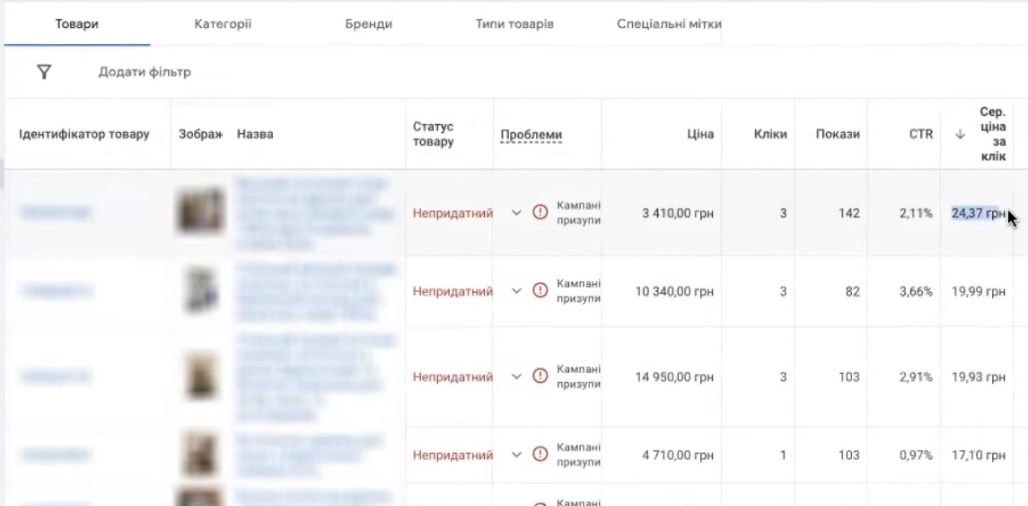
In principle, for the start of a performance it can be, there is a very large variation in the price per click and it will not be a mistake. Because you and I don’t know exactly what kind of hotness of auction this performance is in and who exactly it’s competing with, with what bids or strategies or restrictions. This also pours out not only from what Google offers us, but also from competitors who have their own bids. So, if we filter by impressions, we will see that there is quite a heterogeneous distribution of impressions. For example, for the product 374 UAH, he has spent already 66 UAH. From the point of view of this strategy that you are using, this is not a mistake, even if you earn much less from this product.
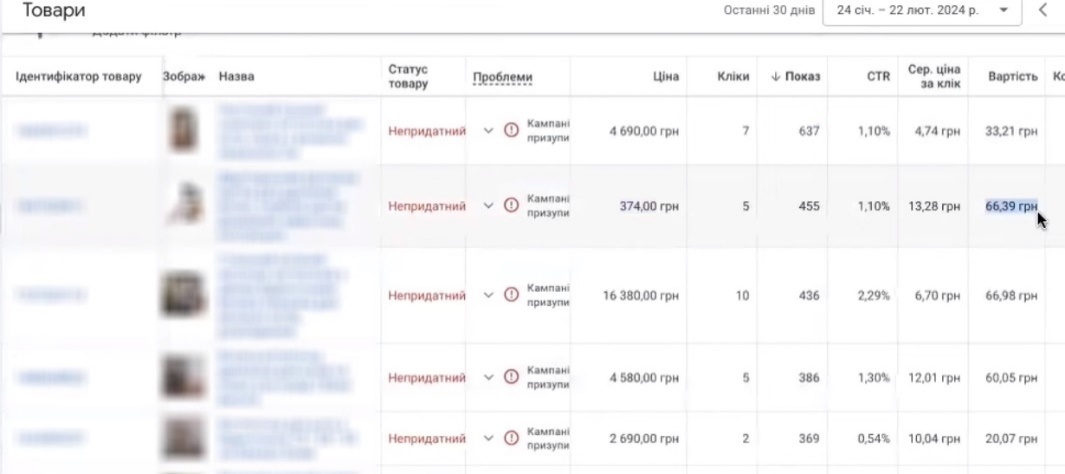
You may not be earning significantly less. It has to be considered individually. Or 79 UAH. Here we have already spent 58 UAH. That is, there is no limit for this strategy, it adjusts to the auction, to the size of the budget, forecast traffic and tries to display goods on this or that format. He sometimes does it quite competently. That is, he understands how and what happens to the goods on the site. The same goods it tries to tuck into the output, to test different checks. Because if we look, for example, at goods with a very high check, they were not left out either. They were also put into displays and even the CTR was quite high – 2.29%.
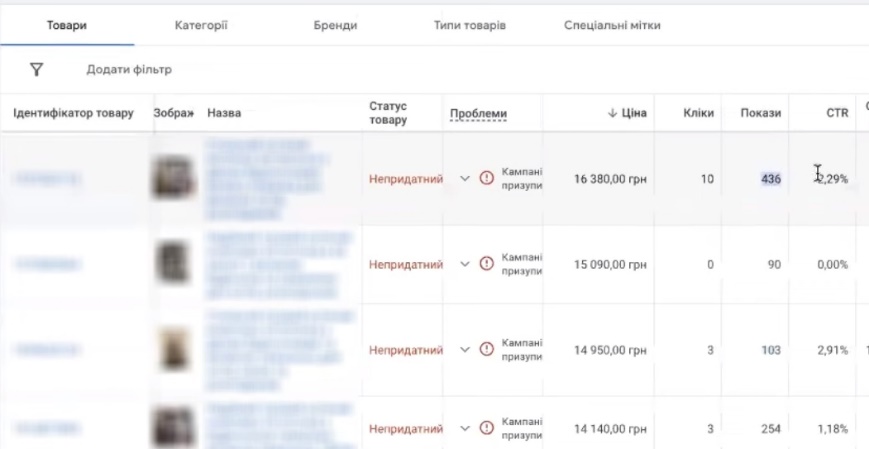
Or take the same budget products. He also put some of it into shows. And remarkably well enough, he didn’t give them all possible displays. He also didn’t give these budget items all the exposure they could get. If you take a purely technical approach, he took your expenses and spread them out. If you take the costs, you just took your 1000 hryvnias and spread it between different products. Another question is whether you earned from it, or not, given the mechanics of launching a performance. So it’s always important to set that profitability.
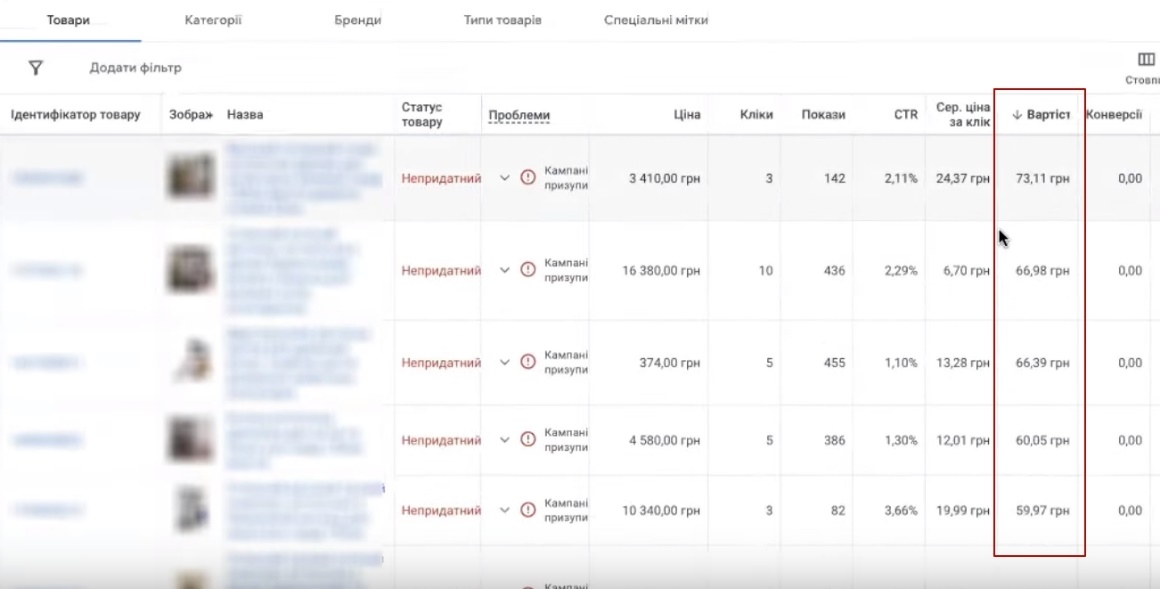
I realize that it may be difficult for you to understand how to set this profitability right away. Because in the days of campaigns like smart shopping, it was possible to set this profitability and it was very quickly achieved by the campaign. There’s no such thing in performance art. I don’t know why they didn’t build in this kind of variation of it. But remember the following rules when setting profitability.
Rules for setting profitability
First of all, in Ukraine you can freely start with such profit margins as 500-600 on average. And it is not directly, not very much will cut your coverage. Second, for a cheaper check, where your margin is very low, you should always set profitability higher. Second, for goods with a very high check, for example, more than 5-6 thousand UAH. went on and on, sometimes it is worth starting with smaller budgets, but with lower margins to then gradually raise this profitability. Why? Because it’s a high check. It will not always be immediately converted into some kind of sale, and it takes performance time for him to try to find a more or less target audience.
So we have already drawn out a few nuances on the basis of what I have said. First, the fact that at least product categories make sense to break down by price, so that for each price range (each online store prices price ranges can be quite different) to set personal profitability. For goods with low margins is better to set profitability higher.
In general, so that you have always in front of your eyes or conducted before the launch of product advertising potovarnoe analysis in the section of the check. Because this size of the price, which is in the column price, it is directly involved in targeting and predicting the work of this profitability under the projected conversion rate. That’s something hard to say.
These checks have a certain margin or markup or something. It is always less on smaller checks. Well, I do not believe that you 50% earn from the goods for 79 UAH and for 5000 UAH. Right? There are different markups, different margins. So remember, on the goods from which you earn the least, where you earn the least margin, you should set the profitability higher.
But keep in mind that this is correlated relative to the price that you have. So there are situations when you launch goods that are quite expensive, for example 1000, 2000 UAH, but they have, for example, quite low margins or there are other price ranges. Then you take this into account in relation to the price tag that you have. You also take into account your sale price. Sometimes it is significantly lower than that price. So also take that into account when you’re adjusting or structuring these campaigns. I mean, I would definitely divide them into at least two or three just price ranges here, this whole story. Why?
Because simply for a cheaper check or it just need to exclude it from advertising, or directly set a fairly high profitability. Cake this traffic, but pull out of there more cost-effective conversions, so that there was no such situation as the price of goods 79 UAH, and you spent 50 or 60 UAH on this item. Do you understand why it is done? To still make restrictions on coverage or on certain goods, or on a certain product range. That is, don’t forget about profitability.
What size budget should I set?
What size budget should be set? Everything is quite individual, but you need to keep this proportion. Where profitability is lower, the budget is lower. Where profitability is higher, the budget should be higher. There are no minimum or maximum values for this budget from which you should start.

Are there no formulas for which you need to predict the size of the budget. There is, for example, a common story among Googlers, when they recommend a budget based on the number of products, there to multiply by a certain number of monthly, some figure to use. In general absolutely it’s kind of a random thing, it may come in, it may not come in. I don’t recommend it. It is advisable to start with smaller budgets. Smaller budgets are always determined by the price per click, traffic volume of your margin. The lower the margin, the lower the budget size should probably be. These are the kind of ratios that should be in place.
Need to remove automatically created objects
Next. For starters, I still recommend removing these automatically created objects. Not because they are super bad or anything like that. No, to eliminate search from the merchandise as much as possible, you won’t 100% eliminate it, but to have that story present. Why?

Because it is worth remembering that in search the price per click is much more expensive than in product advertising. If we remember that when we looked at the overall campaign, we had 1000 UAH spent, clicks are quite few – 120, but the price per click was high. So if we take in the keyword planner “claws”, take or there Russian separately, for example, the same Ukrainian. Take into account that performance art, it is bombed in different languages. We’re going to see a picture like this. That’s the thing to keep in mind. You have a bid. Where is it? You can probably see it here. The rate for the top of the page and for the bottom of the page. The lower the rating of your ad, the more aggressive your competitors are, the higher the price per click you will pay. There are prices for a click of 8, 6 UAH. This is the maximum in order to be shown at the top.

Well, plus equalization for the last quarter. There is a gain relative to the same period in traffic volumes. This aggressiveness will be even conditionally greater. Take into account the fact that if you leave the search – a very high probability that there will be very high prices per click. It is not a hundred percent guarantee that you will have the lowest price per click.
But over time it starts to more or less stabilize. It makes sense to add this search when, for example, a performance has been running for at least two or three weeks, and you see that there is a positive trend in conversion. You are satisfied with either the price per sale or the profitability, then you can add it. Why add it? Because at least in performance there is pre-analytics and there is an understanding of who to target, so under this block of settings, I, for example, would exclude altogether.
Customizing languages
Second, about languages. In general, we need to add these three languages. Because we have a very large block of solvent audiences who can pay a fairly high check even. But they can simply set English in the settings. So you lose some of the traffic.
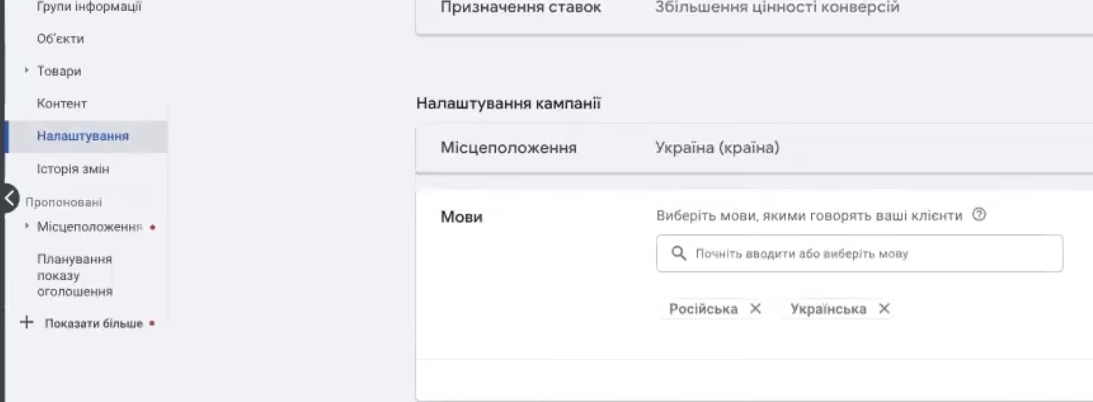
Not only that, but if there is a very large number of purchases from people who are constantly traveling back and forth abroad, I would include all languages. Because very often some single sales come in, for example, from Hungarian or Polish or other languages. There are a couple, two, three conversions. But sometimes it’s pretty nice. It’s all Ukrainians. It’s just that their interface is already customized for the language in which they live. But when they come here, they use it accordingly.
Changing the structure of advertising campaigns and indicating profitability
Okay, let’s go. Next. So we realized what we need to do. It’s definitely the structure of these ad campaigns needs to be completely different. It’s not a mistake to group all products together. But then still set the profitability limits in the settings. It could be an average of 500-600 and then you’ll add on. It can be higher, for example, but you have to see how aggressively or not aggressively the performance is targeted. If anything, roll back a little bit in profitability lower. Remember that just the size of profitability is just a limiter in the shows. That’s it. There’s no magic to this profitability or anything else. It’s more aggressively limiting displays or more somehow lite.
How many calls and sales will I get by ordering contextual advertising from you?
I need to calculate the conversion of my website Describe
the task
in the application
Calculate potential ad revenue Google
contextual advertising calculator
Analyzing who Google favors
Let’s move on. What do we need to see next? In the last few days that we’ve had there, we still need to figure out who Google favors, even with the targeting that we’ve had with no limit.

For example, we see that the number of shows on scratching posts, it’s much higher. 6,000 versus, for example, a thousand on trays and mats. Right? 6,000 is relative to the total number of shows we had. This is quite a large size. It is better to consider it here on groups of objects, so that it would be more convenient, more correct. We have a total of, for example, here they are about, how many? 8,000, maybe 9,000 shows. And the main share of these 9000 or 10000 shows is occupied by scratching posts. You must understand that this product category, it reserves a very high percentage of the budget for itself. That is, your performance can both overspend and underspend.
So, this is another point why, most likely, you need to split the campaign a little bit? In order to stimulate some other categories in terms of impressions, in terms of traffic, in order to still earn money from something. And remember that if you have performances, but they do not complete the entire budget, or there is, for example, a situation where there is 300 UAH, and the budget is sawed off or invested in only one category, it is just historically so with the performance itself – it is easier for it to target, it continues to do it.
Steps to take to improve performance
– Specifying cost-effectiveness
That is, in our case, in order to improve the performance of this performance, one should. First, analyze your margins of goods and try to divide these all goods at least into at least three price sections. Because for each of the price section you will set different margins. For lower where margins are low – lower. For higher checks – lower (!!! – higher or lower?). You’re the ones who divide the proportions there. It’s the same thing you do with budgets. Don’t chase big budgets on these performances. The lower your margins, the lower your advertising budgets should be.
I understand that it may take a very long time, it may be difficult to wait or something like that, you may have some fears, but the faster you twist this budget, the better things may not get. So you have to always adjust these all the nuances under that. Therefore, it would be desirable to divide them into some constituent parts in order to understand which category works better or worse.
– analyzing the uniformity of display distribution
Next. Keep track of what you have going on in your advertising campaigns. For example, I took our scratching post object group. Only our scratching posts are sitting here. What do I see? Basically, the traffic is spread out. Expenditure part is dispersed between some products.

You see, there are some products if we have a campaign suspended. Perhaps they were even ready to be shown, but they were not shown. What we see here is that the expense side for these few days is spread out and that’s it. Also pay attention to this, so that you don’t have a product item that will be a drag on costs or will be very expensive in terms of price per click, or, for example, a drag on displays. This situation also often happens, then it is desirable to exclude it, put it in a separate performance, if you still want it to be advertised.
What will you do this for? To stimulate the performance further, to distribute shows. Because the more typical the request itself, the worse the performance of the performance in terms of distributing shows between different products, regardless of whether there is profitability or not. Just five to ten products will have at least some displays. The rest will have nothing at all. You also need to do a commodity analysis in order to realize that you are excluding things that are dragging down the budget. This is such a small plan of what you can do.
Tune-up after a period of performance training
What else is there to note for this project? A question that is usually asked is how long to wait for performance art to learn. Performance is learning all the time. So it’s an ongoing process. This status of the training that you see there, it lasts from five to seven days. These are the first A/B tests that the automation does. The better it gets into a certain audience, the better it understands where your sales are, the better. But in most projects, even if this period is over, there may be zero results, you have to play with it all. Play in what context? Play, for example, with the same signals that are here.
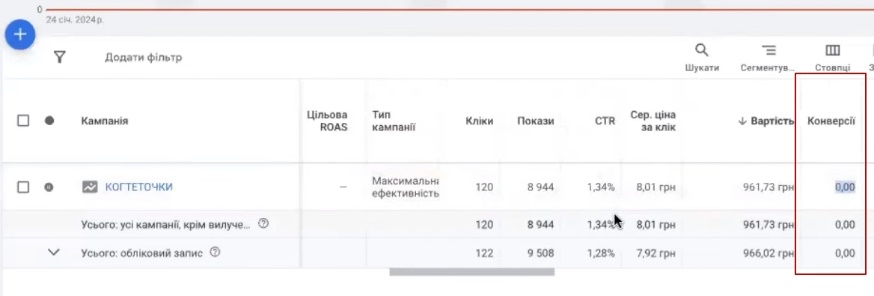
For example, here were selected search terms. These cat toys, there’s big ones, there’s a set, scratching posts and stuff like that. You will have to play with signals in order to refine the targeting of these performances, so that it still takes a narrower audience. But it won’t be a big deal if you don’t even set that signal at all.
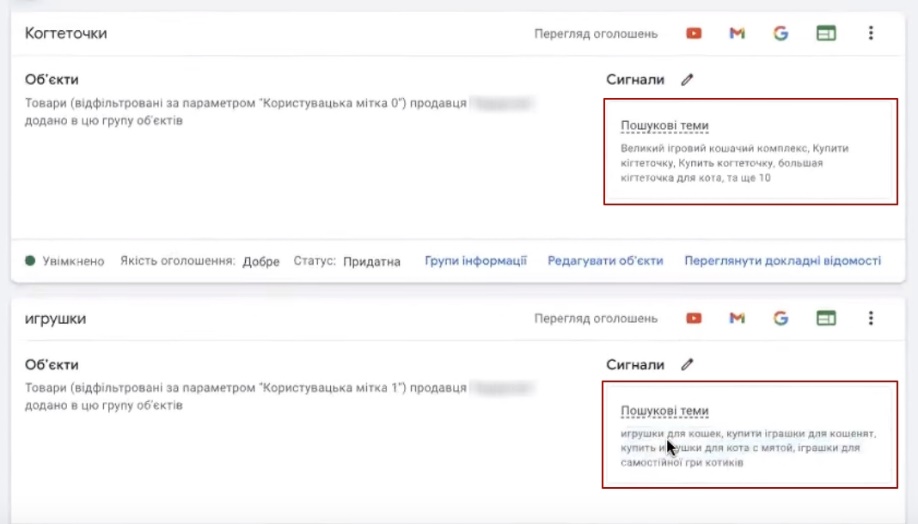
Attention to auction statistics
Yeah, the next thing to look at is your auction stats. Because that’s where the analytics fat is. Why? Because auction statistics often lie to you in terms of how many shows you got there, what quality of shows and so on. Because, for example, here it is drawn 89%, well on 300, there’s how many, here 85%, but it’s unlikely that you’ve made such a decent competition that it’s like a rosette 89, if you just google this rendition.

These indicators are drawn on the basis of those search queries that were collected before in the performance. That is, these search queries can be both correct and incorrect. Therefore, the task will be to chase that you with some stores, for example, of this nature to maximize the similarity, the intersection. You need to review your feed, perhaps even the signals that you have set.
Because according to the signals that we have here, our main competition is with Rosetka, but not with these stores. We need to edit this dramatically. Not only should you try to separate them into different campaigns, but you should also assign different profit margins to each check. Even before that, I would suggest that you adjust these signals. Of course, it would be desirable to see the statistics, but it is in this account to me on search queries, it will be pulled up only in about seven days, and here it has only been a few days, so we will not see it now.
But if we take the statistics of the auction, we see here that the indicators are very cool, we have no result, if we make a hypothesis that we have no conversion, and all the other participants of this game they somehow look weak. But you and I are not sure if they’re wimps at all. Because most of them can have much higher budgets and still get significantly more sales. Keep that in mind. So we’ll need to adjust the signals.
What to correct in the signals?
How much to tweak it for? Well, first of all, here’s a look at the topic of such a niche, you don’t have to set the keywords you have in your feed. “Cat scratching post”, for a cat or something like that. It only makes sense if you need to refine it.

For example, such as this “scratching post for big cat”. If you have outright large scratching posts, you would select just these big cat products here and then add this search terms. Just generating that kind of quantity, you don’t have to do that. Because you already have these keywords in your feed, they will be used as targeting.
Using other sets of signals
But you have a completely different set of signals that you can test and see if they work for you or not.
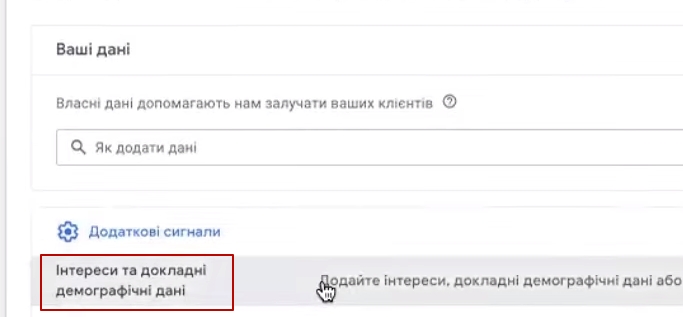
First are life events or interests, then there’s usually something about animals. For example, cats, for example. We will try to find these targetings, as they will be called here. I typed in English, although my interface is in Ukrainian, but I don’t know why it didn’t work for cats. Look, there are cat lovers. See? There are dog lovers.

Well, that’s for sure, it’s not just people googling pictures. These are straight up people who are pretty good at searching for products for these favorites. One. You can test these very broad signals later. There’s this in the “pet” events. Soon to have a cat at home, you realize that exactly, when they want to get a cat, especially an expensive one, they will buy in advance these all scratching posts, litter trays and so on.
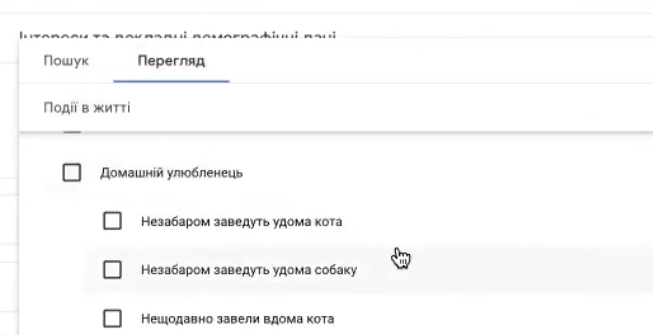
Here’s “soon,” “recently got a cat at home.” Those are really super super targeting. In fact, a lot of people underestimate them because they’re direct targeting that Google understands based on signals of what people have been doing online. You’d be surprised at the queries “catteries” or for example you asked Siri or Ok Google to google some kitties, kitties. You’ve looked at reviews on someone. You’ve gone to YouTube. You’ve gone, even to the same tikToks, instagrams, and you’ve seen Google these all pictures. If you have this voice assistant or Ok Google or Siri connected, then even what is spoken in TikTok is listened to. So if you were looking for a cattery in TikTok, or you wanted to get a kitten, or you went to Facebook pages where you were looking for a free kitten, these are all these assistants, they record everything, they track everything. Not only that, you may notice that if you give rights to TickTock, for example, to access your photos without even saying anything, TickTock can output relevant content. They’re actually not just asking for access to your photos or your photo content because they’re constantly scanning that and based on that, the artificial intelligence can generate new pages of photo content.
So these are the kinds of things that you think are not correct enough, maybe they’re narrow enough, they’re not targeted they might actually work quite well. The other issue then is your suggestion. Still somebody’s site may have a visual look or a little bit better. Someone has better photo content, someone out there has video content about these scratching posts, someone has a sob story of this manufacturer of these scratching posts. Ivan, who loves kitties, here is my Marusya and was once looking for a scratching post for her. Couldn’t find one. Started doing it myself. It’s already all the nuances that affect conversion rates. Remember that the task of performance art is not to find the sale. The task of performance art is to find the audience. To substitute, to put this ad in front of an audience that is at some stage of choosing these products. Just so you understand that.
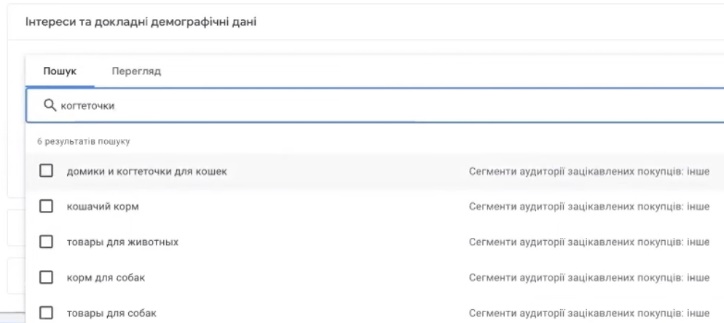
Then you can play with it some more. You can try the same scratching posts. See here, look, because these are very chic targeting segments. “Houses and scratching posts” is right, see, these are segments of interested buyers. It’s got “lodges.” It’s underestimated, it’s not just search terms. There are people who can try to target feeds, something like that, the same pet products, please. There are options for where to go. That is, it is not necessary to set these search terms. They are needed to specify some nuances when you see that the targeting is very broad and you have specific products. Like, for example, only for big cats. Or you have some super big specific these scratching posts. Then that would make sense. And if you take the very keyword that is in your feed, you don’t need to take it. Because Google will understand on the basis of your feed what these keywords are. There has never been such a case, for example, that in the title was, for example, “handbag there for this and that”, and Google picked up something completely different. It understands, it picks up the general semantics. The same applies to toys for cats. That is, you can Google, search in English, Ukrainian, Russian for different keywords and Google can immediately prepare a ready audience for you. This is what makes sense to test in terms of signals, if you really see that traffic is coming and something, some costs are coming, but still you are not satisfied with the result.
Tips for this niche
What can be said for this niche? First of all, remember, always keep in your head your payback rates for different price ranges of products. Because in your niche there are goods that are very budget: toys, some shampoo or something like that, on which you earn very little. Do not cross them with goods with a fairly high check. Because performance art doesn’t care, it doesn’t understand what you earn or don’t earn there. For him, mind you, this indicator, income, they call it value. It is not even called revenue. There are separate revenue indicators that can be transferred, and Google is not focused on them at the moment. It just uses them for reports, but that’s a separate story. Remember that he will not think for you where you earned, where you did not earn as on the product for 79 UAH, but spent something like 50 UAH, something like that.
Second, remember that you need to correctly, if you divide all these price ranges into different campaigns or you divide them within there groups of goods, it depends on your daily budget – correctly distribute their profitability. Well, if we’re talking about profitability, you have to divide them into different campaigns, because we can’t change the profitability at the level of product groups.
We remember that the lower the margin, the higher the profitability. You can start with the same 500-600, but then you have to add a certain percentage, 20%, but no more. 40-50% makes no sense. You can start right away with 800-900%. You start with this profitability and then just add budget periodically in order to increase the amount of coverage. For a more expensive check, you can, on the contrary, set a lower profitability, so that it would still be a priority in the rendition, in the shows.
Yes, the second rule. We are not chasing a budget size of 300 UAH. For such an assortment, it wouldn’t be expensive if we had profitability from the beginning. You can set much smaller budgets. This will not be a mistake either.
Next. Third. Check your signals. If the category of scratching post without a signal does not come in, there are some very broad queries – try targeting people by targeting that says that the person already has this cat or is going to get one, then this is at least a reference point for the system on whom to target. So we even assign an attribution model on “last click” conversions so that the value is still on the last interaction before the conversion.
Next. This remember that a lot depends in this niche on your sob story on the site. There are products that will unequivocally go in quite well, that will go in poorly. Which will just generate traffic and not turn into anything. If it is not possible to finalize the landing page, in terms of meaning, so just exclude these products. You can put them in a separate performance, in a separate sales campaign, and assign a fairly small budget. Let it drag there, if you need to keep advertising the product.
In all other cases, exclude anything that eats up money. It most likely for some reason can’t lead to conversions if the traffic is relevant enough. The traffic is relevant or irrelevant you will understand by two parameters. The first is in the statistics, at least search traffic. And the plus here would be interest-based traffic.

You will realize whether it is good or bad. And according to the statistics of the auction, it is desirable that in the commodity, you still more crossed, well with more equal competitors. Because it’s very difficult to compete with that Maudau. Yes, that’s right, there or Epicenter or Prom or Pethouse. You can compete with these somewhat small online stores. This you will already edit at the expense of the signal.
This is basically the base you need for this niche. Remember that there are some products that will be good enough to go through Google in sales, some will not. So that part will not come in well enough, especially toys. You should try through targeted advertising, through the formation of certain good messages. They will also come in through video creatives. You’ll be happy with these ads.
I’m done for the day.









